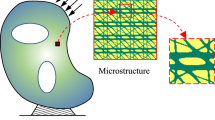Abstract
Several approaches including optimization based methods were developed for mesh quality improvement using only node movement, keeping intact the element connectivity. In this research, a socio-inspired optimization approach referred to as cohort intelligence (CI) was investigated for mesh smoothing. Minimization of summation of condition numbers of all elements was the final aim. The geometrical boundaries of the object defined the surface and edge constraints for movement of external nodes. Movement of internal nodes was completely governed by variations of CI algorithm, viz. roulette wheel, follow best, follow better, alienation and random selection, follow worst and follow itself. The approach was demonstrated with pentagonal prism, hexagonal prism and hexagonal prism with hole. The performance of follow best and roulette wheel variations of CI algorithm was observed to be satisfactory as compared to other variations of the algorithm.












Similar content being viewed by others
References
Acikgoz N, Bottasso CL, Detomi D (2004) Metric based mesh optimization using simulated annealing. In: 4th European congress on computational methods in applied sciences and engineering (ECCOMAS 2004), pp 1–11
Belyaev A, Ohtake Y (2003) A comparison of mesh smoothing methods. In: Israel–Korea bi-national conference on geometric modeling and computer graphics, vol 2
Bern M, Eppstein D (1995) Mesh generation and optimal triangulation. In: Computing in Euclidean geometry, pp 47–123
Dhavle SV, Kulkarni AJ, Shastri A, Kale IR (2016) Design and economic optimization of shell-and-tube heat exchanger using cohort intelligence algorithm. Neural Comput Appl. https://doi.org/10.1007/s00521-016-2683-z
Ho-Le K (1988) Finite element mesh generation methods: a review and classification. Comput Aided Des 20(1):27–38
Holder M, Richardson J (1998) Genetic algorithms, another tool for quad mesh optimization. In: IMR, pp 497–504
Kale IR, Kulkarni AJ (2017) Cohort intelligence algorithm for discrete and mixed variable engineering problems. Int J Parallel Emerg Distrib Syst. https://doi.org/10.1080/17445760.2017.1331439
Knupp PM (2001) Algebraic mesh quality metrics. SIAM J Sci Comput 23(1):193–218
Knupp PM (2003) A method for hexahedral mesh shape optimization. Int J Numer Methods Eng 58(2):319–332
Kovalev K (2005) Unstructured hexahedral non-conformal mesh generation. Faculty of Engineering, Vrije Universiteit Brussel, Brussel
Kolukula SS (2016) PlotMesh source code (version 2), Mathsworks [Source code]. https://sites.google.com/site/kolukulasivasrinivas/. Accessed 17 Aug 2018
Krishnasamy G, Kulkarni AJ, Paramesran R (2014) A hybrid approach for data clustering based on modified cohort intelligence and K-means. Expert Syst Appl 41(13):6009–6016
Kulkarni AJ, Baki MF, Chaouch BA (2016) Application of the cohort-intelligence optimization method to three selected combinatorial optimization problems. Eur J Oper Res 250(2):427–447
Kulkarni AJ, Durugkar IP, Kumar M (2013) Cohort intelligence: a self-supervised learning behavior. In: 2013 IEEE international conference on systems, man, and cybernetics (SMC), pp 1396–1400
Kulkarni O, Kulkarni N, Kulkarni AJ, Kakandikar G (2016) Constrained cohort intelligence using static and dynamic penalty function approach for mechanical components design. Int J Parallel Emerg Distrib Syst. https://doi.org/10.1080/17445760.2016.1242728
Kulkarni AJ, Krishnasamy G, Abraham A (2017) Cohort intelligence: a socio-inspired optimization method. Springer International Publishing, Switzerland
Kulkarni AJ, Shabir H (2016) Solving 0–1 knapsack problem using cohort intelligence algorithm. Int J Mach Learn Cybern 7(3):427–441
Patankar NS, Kulkarni AJ (2018) Variations of cohort intelligence. Soft Comput 22(6):1731–1747
Parthasarathy VN, Kodiyalam S (1991) A constrained optimization approach to finite element mesh smoothing. Finite Elem Anal Des 9(4):309–320
Pyzara A, Bylina B, Bylina J (2011) The influence of a matrix condition number on iterative methods’ convergence. In: 2011 federated conference on computer science and information systems (FedCSIS). IEEE, pp 459–464
Sarmah DK, Kulkarni AJ (2017) Image steganography capacity improvement using cohort intelligence and modified multi-random start local search methods. Arab J Sci Eng 43(8):3927–3950
Sarmah DK, Kulkarni AJ (2018) JPEG based steganography methods using cohort intelligence with cognitive computing and modified multi random start local search optimization algorithms. Inf Sci 430–431:378–396
Sastry SP, Shontz SM (2012) Performance characterization of nonlinear optimization methods for mesh quality improvement. Eng Comput 28(3):269–286
Sastry SP, Shontz SM (2009) A comparison of gradient-and hessian-based optimization methods for tetrahedral mesh quality improvement. In: Proceedings of 18th international meshing roundtable, pp 631–648
Shah P, Agashe S, Kulkarni AJ (2018) Design of fractional PID controller using cohort intelligence method. Frontiers Inf Technol Electronic Eng 19(3):437–445
Yalcin E, Yilmaz AE, Kuzuoglu M (2002) Performance comparison of various hexahedral element quality metrics via parametric distortion of an ideal element. Int J Comput Methods 10(04):1350017
Yilmaz AE, Kuzuoglu M (2009) A particle swarm optimization approach for hexahedral mesh smoothing. Int J Numer Methods Fluids 60(1):55–78
Zhang S (2005) Subtetrahedral test for the positive Jacobian of hexahedral elements. Preprint. http://www.math.udel.edu/~szhang/research/p/subtettest.pdf. Accessed 17 Aug 2018
Author information
Authors and Affiliations
Corresponding author
Additional information
Publisher’s Note
Springer Nature remains neutral with regard to jurisdictional claims in published maps and institutional affiliations.
Rights and permissions
About this article
Cite this article
Sapre, M.S., Kulkarni, A.J., Chettiar, L. et al. Mesh smoothing of complex geometry using variations of cohort intelligence algorithm. Evol. Intel. 14, 227–242 (2021). https://doi.org/10.1007/s12065-018-0166-0
Received:
Revised:
Accepted:
Published:
Issue Date:
DOI: https://doi.org/10.1007/s12065-018-0166-0




